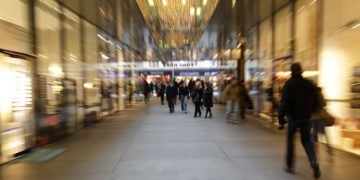Katrina Gulliver in City Journal:
 When I was 12, I went to the mall after school to look at a dress in the window at Laura Ashley. I pined after that dress. And Laura Ashley, unlike the fast-fashion outlets of today, kept the same dress in the window for weeks, its floral print illuminated by fluorescent lights.
When I was 12, I went to the mall after school to look at a dress in the window at Laura Ashley. I pined after that dress. And Laura Ashley, unlike the fast-fashion outlets of today, kept the same dress in the window for weeks, its floral print illuminated by fluorescent lights.
Making people want things has always been part of mall design. In their ideal form, malls offer a smorgasbord of shopping options in a safe, climate-controlled environment. Around the next corner is another store, with another window, offering something new. Meantime, one finds places to eat, places to sit, and piped-in music to maintain the mood. What you want is not simply the object you shop for but to be at the mall. The “Gruen Transfer,” named for mall designer Victor Gruen, is defined as the point in time that mall-going ceases to be about running an errand and becomes about enjoying the visit itself.
As architecture critic Alexandra Lange notes in Meet Me By The Fountain, “People love to be in public with other people.” For the suburbs, malls offered this experience in the way that parks and town squares had in the past. Like railway stations and hotels before them, malls created a zone of public-private space: private property, yet open to the public to use within certain bounds. They are enjoyed by groups as diverse as white-haired walking groups, teenage truants, and representatives of fringe religions scouting for recruits.
More here.
